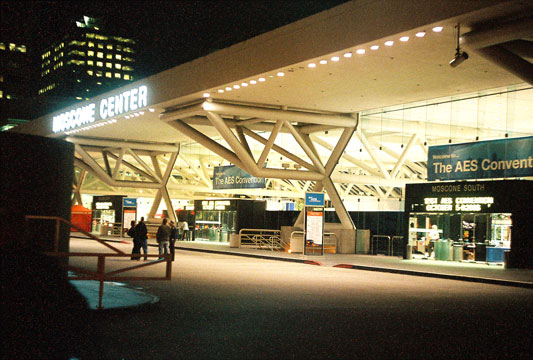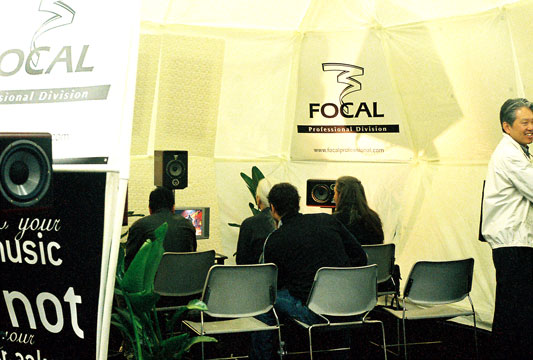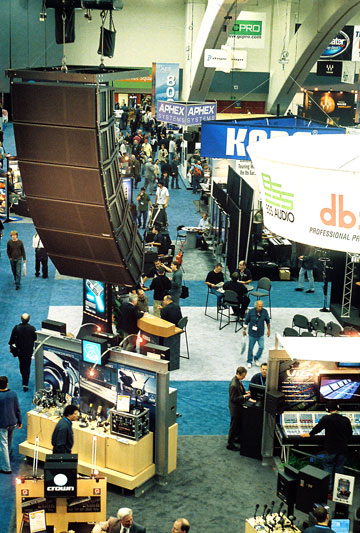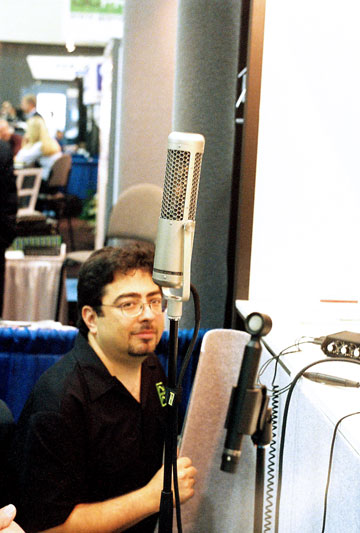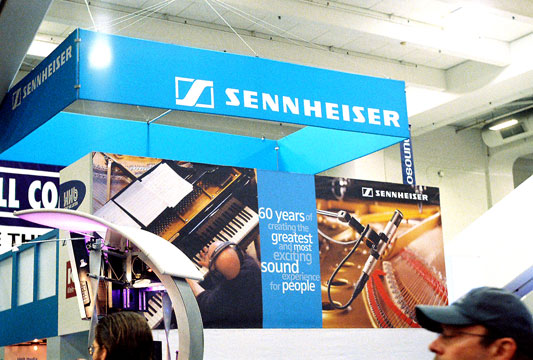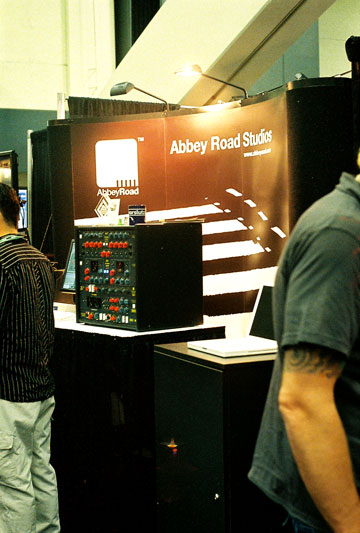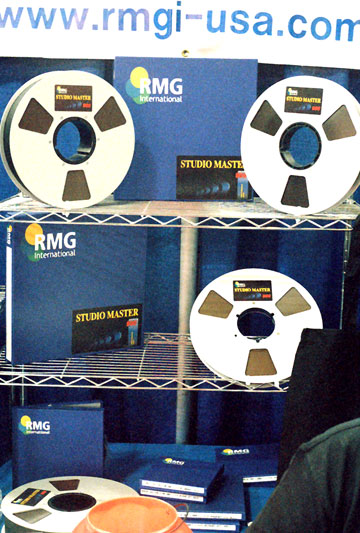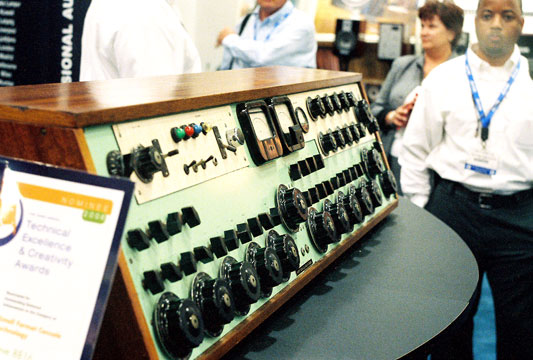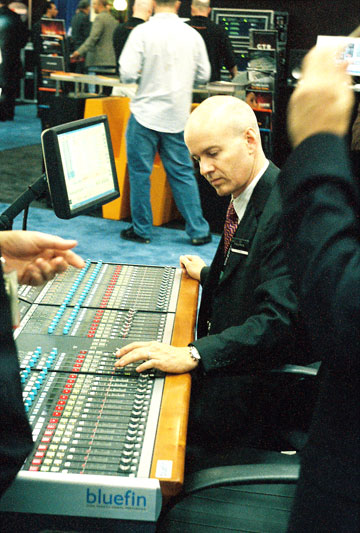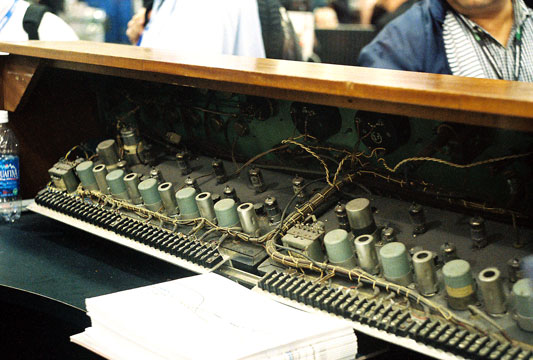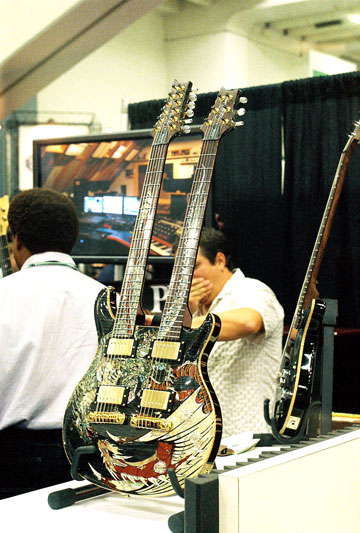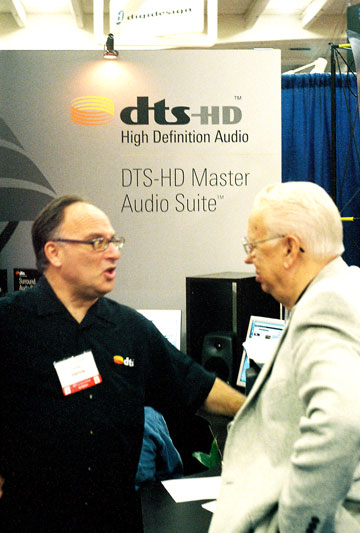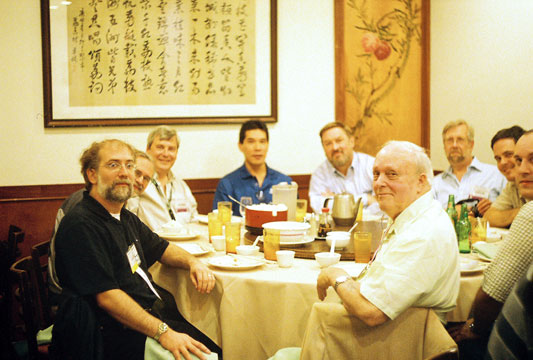|
You are reading the older HTML site
Positive Feedback
ISSUE
28
AES 2006 Show Report
The Audio Engineering Society puts on a show in the US every year, and what makes it kind of interesting is that it's actually two shows taking place at the same time and every year the groups become more separate. There is a trade show with vendors showing the latest in professional audio gear, while at the same time there is also an academic conference with people giving papers and trading information about audio. Twenty years ago you saw the average attendee moving between these two groups; today it is more common to find people going to one or the other and not mixing. Every year I try to write up a show report about both sides of the show, blend them together, and talk a little bit about why manufacturers should look more into the theoretical side and why academics should look at the commercial side a little bit. This year it was made a little bit more difficult in that the show was cut in length by a day. Interestingly enough, they cut a weekday rather than one of the days on the weekend, as if they are trying to avoid rejecting non-professional attendees who might be coming out on the weekend.
Even shortened, it was still an interesting show, with a lot of new products and a lot of research. I will say that I thought the average quality of the papers was down somewhat this year, but at the same time the technical presentations and the new master classes added this year more than made up for that. I do also want to say that this is a whirlwind and very compressed show view, more of a Hollywood gossip column than anything else. So don't take any of this as gospel. I left out a huge number of products and papers not because they were bad in any way, but because they didn't look as interesting to me and I had a limited amount of time. The reviews are very much off the cuff, so don't be offended if you think I've slighted anything. With that said, let's take a short look at what was going on down on the show floor... SPEAKERS
ADAM had on display their line of monitors using a tweeter that is basically adapted from the old Heil ESS design. They have a somewhat etched and glassy top end, but are extremely detailed and still very natural. They sell a lot of different models of different sizes using the same technology, although I might recommend the MP1 mastering monitor as being an excellent possibility for a powered home system. Musikelectronic Geithain was there too, and I just want to say that these folks make some of the best sounding box speakers I have ever used. Olaf August from the factory in Germany says that they have finally managed to get some US representation, and that MEG-AUDIO in Santa Monica, CA, is now carrying their line. I can't say enough good things about these things, and I apologize for constantly misspelling their name. Fostex had the NX-6A powered nearfields, larger versions of the monitors they have shown at previous shows. These are standard 2-way units, but with very odd-looking woofers that are designed to minimize cone breakup modes by rippling the cone. They also had some odd omnidirectional tabletop speakers called the GY-1 that use magnetostriction to move a diaphragm; these definitely are not high fidelity but the driver design is radically different than anything else made today and the principle may well have promise for higher quality designs. Masaki Shimmachi didn't have much information on the GY-1 but promised more soon! Hosa Technology was showing off their Cue 5 "All-Digital Studio Monitoring System" which consists of a pair of small 2-way bookshelf speakers with built-in amplifiers, D/A converters, and a wide variety of inputs with balanced and unbalanced analogue, coax and optical S-PDIF, and remote control through RS-232 and Ethernet. The demonstration sound was poor, with no detectable midrange to speak of, but the idea is still a good one. I went to a speaker demo that I really wanted to like. ATC was demonstrating a full 5.1 system using their loudspeakers, speakers that I know to be good. They were driven through the Meitner EMM converters, from a Sony Sonoma workstation, playing back DSD audio. This is not poor quality equipment. This is high grade gear that I know is capable of excellent sound. But the demonstration used recorded material provided by Telarc, and I was shocked not only at how close-miked everything was, but also by the bizarre panning that was reminiscent of the ping-pong mixes that killed quad back in the seventies. One instrument in each corner of the room... the vocal panned full forward left, the guitar panned full rear right. Drums spread out all across the room. It wasn't even remotely realistic, and was almost painful to listen to given what I know these companies are capable of. Not really a speaker, but still worth putting in this category is the Future Sound FS1 high definition earphones. A lower cost version of the in ear monitor units, these are being sold through XtremeMac for consumer applications. These are in-ear headphones that have a very good seal and give excellent isolation from outside sounds. Also not exactly a speaker, the Dolby Lake Processor was on display. This is a DSP box intended for speaker processing, built by a small company in Australia that was bought out by Dolby. Not only will it allow you to set up four crossovers in one box, but it also has a lot of interesting equalization features including the ability to create asymmetric filters. Intended for sound reinforcement applications, the ability to build crossovers in the digital domain with independent control of frequency and phase could have a lot of other applications. L'Acoustics, long known for their line arrays used in large theatre and stadium jobs, is now selling some small powered sound reinforcement speakers intended for club work and fill speakers in larger systems. They sounded pretty clean, if rather processed-sounding, but they sounded very much the same everywhere in the room with no pattern control problems. Their 108P and 112P are worth looking at for a lot of applications where you need a lot of level from a small box, need something very rugged, but still need to be able to make a convincing reproduction of an acoustic instrument. Bob Alumbaugh did a great job of demonstrating the things. Selenium was selling a wide range of high grade PA drivers, and this Brazilian firm appears now to be doing some of the engineering here in the US. I have always liked their bass drivers, and they have a few coaxial speakers (which were very interesting to discuss with their guy Tom Gallagher) as well as some excellent-looking horns and compression drivers. JBL was showing their LSR4300 monitors. These are reference monitors that come with some dsp inside and a measurement mike that allows you to press a button and automatically equalize the low end response at the listening position. The demo I heard had some serious low end problems, probably due to the room, which just goes to show that low end EQ may be useful but is very limited.
Downstairs in the paper sessions, Jack Ocklee-Brown was discussing similar systems and where those limits are. In Pole-Zero Analysis of the Soundfield in Small Rooms at Low Frequencies he did a nice discussion of modeling low frequency reflections in small rooms and showed some sample attempts to correct for these problems using DSP. He also goes to show that the locations of the peaks and dips in the room are independent of the source and listener locations. This paper is an excellent overview of low frequency issues in small rooms, as well as a good demonstration of what can and cannot be done with dsp "bass correction." Preprint 6986. Antii Kelloniemi and Kari Mettala from Panphonics talked about A Plane Wave Transducer: technology and applications as a poster this year. These folks have constructed an electrostatic loudspeaker using a flexible foam material with metallization. As a planar source, it is very directional, but what is interesting is that it can be bent slightly in order to control directionality in different planes. They use external high-voltage polarization and a high voltage signal source like conventional electrostatic speakers, but the way the membranes are suspended is quite different. Preprint 6945. Panphonics was also showing some commercial versions of these products downstairs on the show floor. There were other great papers about electrostats this year. Dar-Ming Chiang and Jen-Luan Chen from the Industrial Technology Research Institute in Taiwan described A Novel Flexible Loudspeaker Driven by an Electret Diaphragm. They managed to construct a new flexible electret material using a flouropolymer that was filled with very fine pores. They had on display a small electrostatic speaker built using the electret, which could be rolled up and folded. The frequency response was well below audiophile standards but as a proof of concept it was very interesting, and the future of roll-up speakers for computer laptops could be worth investigating. Another fun talk was John Vanderkooy's presentation The Acoustic Center: A New Concept for Loudspeakers at Low Frequencies. This paper introduces a very simple idea: for a single driver in a single box treated as a point source, there has to be some center point somewhere in the box that is the "virtual point source." That's the point around which polar plots should be made, and is important for modeling how low frequencies are influenced by placement. This isn't a completely new idea, but Vanderkooy shows why it's a useful way of thinking about speakers. Preprint 6912. Reiko Okimura from NKH presented users with a large array of speakers and played back recordings both phantom images from a stereo pair of speakers, and individual images from a single speaker placed somewhere in the field. It was found that users could distinguish the difference between the two and that the distance to the phantom image could be detected, although it was hard to understand if the phantom image was created with simple panned stereo if there were phase differences introduced between channels. To be honest it was difficult to find anything in this paper that has not been better addressed elsewhere, I thought. Preprint 6891. Lidia Lee and Earl Geddes, long time perceptual researchers who have done some very exciting work in the past, gave a talk on Audibility of Linear Distortion with Variations in Sound pressure Level and Group Delay. These folks in the past have done measurements of audibility of various forms of distortion, and this time they did a study on audibility of given distortion signatures versus level. It was found that changes in level did affect the audibility of distortion products, which of course implies that the auditory system itself is nonlinear. Now, we've known that, but this is an important first step toward quantifying it and understanding it. Preprint 6888.
In An Experimental Verification of Localization in Two-Channel Stereo, Eric Benjamin from Dolby Labs took some test tones that were located in different places in the stereo field both by intensity and delay, and played them back through three systems. He used a treated studio, a typical home living room, and a car, with subjects who were asked to point out the position of each tone as they were played back. As you might expect, listeners in the treated room came very close to the theoretical limits, while listeners in the car found location very difficult. Nothing here is terribly innovative, but it's a great summary of the limits of human perception with regard to imaging and a good argument of the importance of room control. It's well worth having a copy of this if only because it is a good response to people who claim that one can or cannot hear given localization effects. Preprint 6968. In Stress Analysis on Moving Assemblies and Suspensions of Loudspeakers, Fernando Bolanos from Acoustica Beyma in Spain demonstrated finite element models of loudspeaker surrounds and spiders to show how forces act on them as the cone is moved and how sub-harmonic signals can be inadvertently generated by the compression forces on the flexible elements. Preprint 6939. Andrew Unruh from Tymphany gave an overview on their Linear Array Transducer in Linear Array Transducer Technology. This seemed like more of a marketing talk than anything else, but I still mention it because the notion of the LAT, a tube filled with opposing pistons, is still one of the more interesting approaches to compact bass drivers. Preprint 6937. In An Extended Small Signal Parameter Loudspeaker Model for the Linear Array Transducer, Unruh and some other folks from Tymphany describe how the standard Thiele-Small loudspeaker model can be extended slightly to describe the action of the LAT. That one is preprint 6883. Another fellow from Tymphany, Claus Futtrup, spoke on Design Considerations for Shallow Subwoofers. He's looking at constructing a speaker driver with the support spider actually in the middle of the magnet assembly, in order to reduce the depth of the magnet assembly. This means speakers with a longer X-max and therefore higher output can be built with the same depth, for applications where driver depth is important. These vary from car speakers that have to mount in door panels on up to cinema sound systems that need to fit behind a projection screen. Preprint 6944. An interesting approach to reducing distortion in loudspeakers is Bo Rodhe Peterson and Per Rubak's paper Linearization of Nonlinear Loudspeakers. These guys talk about how the only effective feedback information you can get from a conventional loudspeaker is current vs. voltage data at the speaker terminals, since the speaker is only a two-terminal device with no sensors on it. Therefore, they construct a model of the speaker (using external measurements) and build an inverse of that model to linearize it. This reduces distortion substantially, and it's a process that has been done before many times as part of DSP speaker processing systems. But what these folks do that is interesting is that every minute they use the available current vs. voltage data at the speaker terminals to verify the speaker model, and they use it as feedback to change that model. In this way they can compensate for device aging effects and (in a mass-production environment) would be able to compensate for variations between drivers. An interesting approach to the problem. Preprint 6941. Acoustical Stuff Auralex Acoustics was selling a new line of absorption material. Called SonoSuede, it's a standard panel absorber, but with a really nifty covering that looks like ultrasuede but does not impede the effectiveness of the panel inside. Noren Products was showing off their Acoustilock cabinets, designed to quiet down computer workstations, amplifiers, or any other noisy gear that has to be operated in a quiet area. I can think of so many different applications for these, from tape transports to home theatre systems. Realtraps had a variety of new products, but the most interesting was the RealTraps diffuser. This thing is a bass trap and effectively presents an impedance match to free air to absorb bass waves, but at the same time it has a diffuser in front which randomly reflects higher frequency sounds. This allows you to keep your room comparatively live, while at the same time fixing standing wave problems on the low end. IAC was showing off their line of sound control doors, which do a very good job of keeping sound in one room and out of the adjacent ones. With good construction practices and floated floors, most of the leakage in and out of listening rooms is through the doors, so devices like this can make a huge difference. Saafil Acoustex was showing their line of acoustical fabrics, intended for everything from speaker and microphone grilles to internal acoustic filters inside drivers. These are high precision fabrics, not just intended to be acoustically-transparent but also to have controlled resistance characteristics at various frequencies. MSR was showing a whole line of different acoustical products, from diffusers and absorbers to isolation hangers and floated floor systems.
Transformers Lots of transformer vendors this year! Plitron was there with their usual range of high quality toroidal power transformers, and Per Lundahl from Lundahl Transformers was showing off not only their excellent line level audio transformers, but also a line of high-grade C-core transformers for tube amplifiers. Both output and power transformers are available, and the output transformers look excellent. Toroid Corporation of Maryland was also showing off some high quality toroids, and Ming Xu, one of their design engineers, was very happy to show me around the product line. Of great interest is the fact that Triad is now on their own again, no longer a part of Magnetek, and they are looking to introduce a lot of the classic old Triad designs. They have all their old drawings and are trying really hard to make the more popular vintage designs available to users. They're gearing up right now, but they are right now soliciting requests for designs to resurrect so if you are at all interested in any of their older products, give them a call. This year we got a company from India called Miracle Electronic Devices. They make some nice-looking toroidal power transformers, and also a few audio transformers intended for 70V PA systems. I asked about higher quality audio transformers built around toroid cores, for tube amplifiers and other high-grade applications and they said they were looking at that market, which is why they were at the show. A company called I-Tech was showing off a wide variety of small audio transformers and inductors. Lots of chokes and telecom transformers, but no high end stuff. Even so, some of the chokes looked worthwhile, and available in small to medium quantity lots. Cable Belden was there at the show with some new lines of ruggedized Cat5e cables for field applications. Their CatSnake materials look pretty solid for outdoor temporary work at festivals or military encampments, and cat5 is being used more and more for audio transfer as we get better quality transformer balancing available today. Steve Lampen was very delighted to sit down and talk about cables to anyone interested. Gotham also had their line of quality cables, including a three-conductor cable called the GAC-3. This is intended for balanced audio, but with the ground and shield connected together at only one end of the cable. Neumann has been promoting this configuration for years and it's a good way to manage shields. Scott Fehl from Gepco had their cables on display, and they not only make a 17 pf/ft mike cable called the XB201M, but they also make a siamese S-video cable that I swear is one of the best things around for moving unbalanced stereo audio long distances. Marshall Electronics also had the Mogami line of high grade pro audio cables on display; these folks sell some of the most tightly controlled balanced cables around, as well as oddities like a fine tube mike cable. Phil Tennison, the technical sales guy, was very happy to talk about their line. On a very different note, the folks from Vovox in Switzerland were showing off a line of high end cable, including speaker cables, balanced and unbalanced interconnect cables. Some very interesting construction, but they looked solidly built and I would really like to have heard the things.
Microphones Lectrosonics was showing their new Model SM, which uses an internal DSP system to emulate the compression and emphasis characteristics of many different vendors' UHF wireless microphones. This means that no matter what receiver you have in the rack, you can use the Model SM with it, and that is a huge deal in a world where interoperability between wireless mike systems is almost nonexistent. Charter Oak, Pearlman, and Horizon were all introducing new microphones based around the standard Shanghai-style capsules but with their own tube electronics. Sabra-Som was showing off their line of new microphone mounts; their latest product is a combined shock mount and pop filter. I like these guys' products because they have so many different little pieces that you can mix and match together to build all kinds of things.
Josephson Engineering had their regular line out, including their C617 microphone, which is a phantom-powered mike that uses a 200V nickel diaphragm measurement capsule. These capsules give amazingly accurate response off-axis, and they are the most omnidirectional omnis I have ever seen. The mike can be purchased either with a Microtech Gefell capsule or you can use them with other 1/2" IEC Type I externally-polarized capsules like the B&K types. DPA was showing their 4041, which uses a larger version of the same capsule with an electret backplate. Again, it allows you to use the nickel-diaphragm measurement types with standard phantom power. The larger capsule is a little more directional at high frequencies as well. They also showed their SSB6000 Stereo Satellite Box, which allows a number of small electret microphones to be plugged in simultaneously into the same mixer channel, with the outputs summed together. This can be very handy for standard fixed installations with a number of microphones, or for cases where a player may have several microphones mounted on an instrument and wants to provide a single feed to the sound system. At the Paris AES convention earlier this year, Eddy Brixen from DPA did a short paper on empirical testing of wind noise with condenser microphones. This fall he did a follow on, Wind Generated Noise in Microphones–an Overview–Part II." In this paper, he took a number of conventional dynamic microphones and subjected them to wind from a calibrated fan source, then normalized the resulting levels to the sensitivity of the microphones. He found many of the things you would expect: omnidirectional microphones were less sensitive than cardioids, ribbon microphones had severe problems, and microphones with small cross-sections had less noise than physically larger mikes. But he also found that, all other things being equal, dynamic microphones were no quieter on the whole than condensers. This flies in the face of some conventional wisdom but makes perfect sense when you look at the study. Preprint 6879. Juha Backman from Nokia talked on a Gradient Microphone Design using Miniature Microphone Arrays. This was a conventional subtractive array and the paper is worth reading as an overview of the technology, although he neglects to mention some longstanding published work which rather indicates the impracticality of these configurations. Preprint 6878.
Recorders One of the most exciting things at the show was that Korg was showing their MR-1 and MR-1000 portable DSD recorders. Although SACD does not seem to be making a huge showing in the market, the availability of small and convenient recorders capable of making masters for SACD releases is a big deal and a huge step toward making it possible for smaller labels and individuals to release on SACD. Everyone and his brother, though, was making some kind of handheld recorder this year. Core Sound was selling their PDAudio, a little gadget that plugs into the Compact Flash port of a PDA and turns it into a 24-bit audio recorder. Len Moskowitz was very helpful in explaining the advantages of the thing. Nagra was showing their handheld ARES-M recorder intended for the radio industry in Europe (where broadcasters still care about sound quality). It will record linear 16-bit audio as well as MPEG 1 compressed audio into internal memory, then allow you to edit it or download it to your computer through a USB port. Like all Nagra products, it's beautifully machined and built to last through Armageddon. Sonosax, another longtime Swiss manufacturer of portable machines, was showing their Mini R32 recorder. They also have their SX24 handheld field mixer available for it as well. Alcorn McBride was making an interesting thing...their Digital Binloop device allows playback of 32 simultaneous digital audio tracks or MPEG-2 encoded video signals, in one box. The material itself is stored on flash memory cards so you can easily change it or move it around. This was designed for applications like museums or amusement parks where a large number of different audio and video feeds need to be managed from one place, but I can think of all kinds of neat tricks you could play with it. Stephan Flock from RME was there showing off their line of converters. These guys make A/D and D/A converters of pretty good quality, both to replace the converters on standalone gear as well as front-ends to computer workstations. They also make some nifty format conversion hardware like MADI-to-AES/EBU-to-TDIF-to-Lightpipe boxes.
Tape Quantegy was introducing magnetic film. For many, many years, 3M was the major vendor of magnetic film, as used both in the film industry and for some high end audiophile recordings by Everest, Command, and Mercury. Now that 3M is gone, Pyral has become the only vendor of magfilm, and Quantegy has seen a gap. They have introduced 35mm film with the same coating they use on the high output GP-9 tape, which is far higher performance than anything 3M ever made. This is a very small market today, but it's a good one to be in because there isn't any competition. RMGI was very pleased to actually be shipping large quantities of quality recording tape for the first year. These folks have a factory in Holland which has been producing tape since the sixties, but they have now purchased the formulations and some of the equipment from the BASF factory and are now making equivalents to the BASF SM900, SM911, and SM468 tapes. What is more you can actually pick up the phone to your local distributor and get some right now. Finally there is some viable competition in the market. In Solving the Sticky Shed Syndrome, Charles Richardson attempted to disguise a sales promotion for a backcoating removal product as an academic paper. He proposes that all sticky shed issues are caused only by backcoating breakdown, and therefore removing the backcoating solves them. He then proceeded to interrupt the question and answer session of the next paper in an attempt to rudely continue promoting his process. Preprint 6969. In Tape Degradation Factors and Predicting Tape Life, Richard Hess gave a clear overview of a number of different degradation mechanisms that apply to different tape types, how they work, what tape types they are encountered with, and what has been done to address them. It's not any new and innovative research, but it was a clear overview of many years of different research all condensed down into one concise presentation. Well worth getting a copy of if you work with older tapes of any sort. Preprint 6970.
Consoles Malcolm Toft was there, showing off the Toft Audio Designs ATB console. This is a standard old-style modular console with a Trident-like layout, built in China by the Studio Products guys, but built with configurability and maintainability in mind. It looks like a real console at a low price point, and there really isn't anything else like that out there right now. They were showing it last year at the New York show as a prototype, but this year they are actually shipping them. Logitek was showing off their large-format Artisan console, which, like a lot of newer consoles, consisted actually of a digital routing processor controlled by a "console" control surface through which no actual audio flows. This allows the system to be reconfigured in all sorts of ways for different applications and different users.
Lawo was also showing off their MC2 66 console, which has a similar configuration but is mostly designed for broadcast applications. They even have some frame configurations specifically sized to fit into standard trailers for remote broadcast work.
Another digital broadcast console that was fairly new to the show, having only been introduced a month ago, was the Calrec Sigma. This is a large frame broadcast console, set up for full 5.1 use, built around a single standard DSP building block that Calrec calls the Bluefin. There's a lot of CPU power in each box, and since there are lots of individual boxes and the signal paths are distributed, failures will be limited in nature rather than catastrophic. Just like analogue boards, if one channel strip dies you can still keep the show going. Processing Retro Instruments was showing their new reproduction of the original Gates Sta-Level compressor. The Sta-Level was a level control amplifier using variable-mu tubes that was popular in AM broadcast chains in the fifties, but today it has become very common as a bass effect. The reproduction is quite faithful to the original design, but with the option of using different variable-mu tubes than the now-rare original 6386 types. At the same time, Chameleon Laboratories was showing their Model 7062 channel strip. This is a reproduction of the old Neve 1073 channel strip that is found in lots of old Neve consoles. It is a mike preamp and equalizer in one box, and to the original Neve design the Chameleon folks have added a DI for instrument use.
Elysia, a new company from Germany, was introducing their Alpha compressor. This is a very interesting compressor design, with the ability to link channels, but also to equalize the sidechain for selective effects like de-esssing, and also the ability to split mid and side signals for separate processing. The mid-side matrixing is reminiscent of that on the original Fairchild 670; it's a handy thing for LP cutting but it can also be used in a lot of places where you need to alter stereo imaging. LaChapell Audio was another new company here. These guys make a two-channel tube preamp, all symmetric push-pull triode stages inside and with Jensen input and output transformers. It's nothing innovative, but it's a well-built example of a good design that is definitely worth auditioning. Too many "tube preamps" today are nothing but silly gimmicks; this one is real. Crookwood, a British company which is mostly known for their excellent "Paintpot" remotable preamplifier, had on display also some very sophisticated routing and level control systems for mastering laboratories. Most of them are custom-designed but they had a couple of examples on display; they have some simple routers as well that act much like a line-level preamp for a home stereo system, but with extremely good channel matching and tightly calibrated meters. Crispin Herrod-Taylor knew the line very well and was very informative about their custom work. Reverberation removal has been a sort of holy grail for the past century or so in audio. Everybody wants some miracle box that will take the room reverb out of a recorded track, and it doesn't exist. However, there is research being done toward ambience removal for very limited applications, mostly speech applications for teleconferencing and the like. The latest in a long line of research is Blind Dereverberation of Audio Signals Using a Modified Constant Modulus Algorithm by Hesu Huang and Chris Kyriakakis. It doesn't work the way people would like it to, but it can be of benefit in limited circumstances and that's more than anyone else can say. It's another step toward someday having something more general. Preprint 6974. As mentioned in the sidebar, API has opened up the standards for their 300-series and 500-series processing racks, so lots of companies are now making modules that fit into the API racks. Gordon Smart from API talked a bit about the consortium of manufacturers they are building up around their standard, and I have to say this was some of the best news at the show this year.
Parts Bourns was there showing their line of available potentiometers and potentiometer assemblies. This is a big deal in a world where pots are becoming rapidly replaced with digital controls and many formerly-standard types are becoming difficult to find. Kilo International was showing off their line of high quality machined aluminum knobs, which are just the thing you need for those potentiometers. Chris Johnson knew a lot about the line and pointed out that they are currently available in small quantities through Digi-Key. THAT was showing off their line of semiconductors adapted for audio applications, including balanced line drivers, compressors, transistor arrays, and an excellent mike preamp. They say they are going to have distribution of small quantities through Mouser Electronics really soon now and that this time they mean it. Even the Sony guys were showing off integrated circuits; the Oxford technologies division was showing off a variety of SuperMac components like the SOX-SM10 transceiver IC. SuperMac is a nifty new interconnect that allows transfer of both multichannel DSD and PCM data; I would like to see it become more popular and start to compete with AES/EBU and S-PDIF interfaces and that will only happen if manufacturers can get the parts to do it. Power Torus Power was showing a new line of isolation units, built with large toroidal transformers, both rackmount and standalone. Very solidly built with good noise suppression characteristics and the ability to deal with noisy building grounds.
Magazines One of the interesting things about the show for me is that I get to hang out with a lot of members of the press and see a lot of new magazines that don't necessarily have the best distribution. Not only are the usual big name pro audio magazines like Recording, Mix, EQ, and Pro Audio Review represented, but also lots of magazines that have some relation to audio and some smaller magazines. For example, there were representatives from Videography at the show, looking at audio-for-video stuff and handing out copies of their magazines. Vance Dickason's Voice Coil magazine was there too; it's aimed at speaker manufacturers and is worth reading just to see the advertisements and reviews of OEM speaker components. Multi-Media Manufacturer is another magazine more aimed at manufacturers of consumer gear than anything else, but very welcome at the show. The excellent British magazines Sound On Sound, Audio/Media, and Resolution all had representatives there, and I might add that it is actually possible to get subscriptions to these three here in the US, and while they are expensive, they have technical standards well above any of the American mass-market magazines. The Japanese video production magazine Full Digital Innovation also had a representative at the show. Future Music appears to be a new magazine catering to the already somewhat crowded Recording/Mix/EQ/PAR sort of market, though it seems to be aimed at a younger crowd and with some strong attempts at blurring the line between content and advertising. Something really interesting showed up in the magazine stacks this year, though: Editor's Guild magazine. This is a magazine published by the Guild and distributed to members. It's about film editing, and the discussion of audio in it comes from a very different viewpoint than I'm used to seeing. Being a union organ, of course, it also has some discussion of union issues, organizing, and other national labor union discussions. Not really a magazine per se, the APRS (Association of Professional Recording Services), a British organization, was giving out copies of their bi-annual handbook. These are handy directories of studios and events as well as a good overview of the current state of the recording industry in the UK.
Weird Stuff Day-Sequerra, manufacturers of some of the world's best FM tuners, was showing off their latest design, the M4 HD Radio Tuner. This device allows for high quality reception of standard AM and FM analogue signals as well as the digital IBOC signals now being broadcast on the AM and FM subcarriers. These are aimed at radio stations who want accurate monitoring of their signal quality, but the previous Day-Sequerra gear often found use in audiophile home systems. The demand for this sort of gear in the home is dropping as FM quality continues to deteriorate in most places, but for folks who do have good local broadcasters it is well worth trying out. Violet Audio in Australia was selling something called their ADP61, which looked rather like a home A/V receiver, without the amplifier stages and with extremely tight calibration. It has various analogue and digital inputs and video switching that follows the audio switching, as well as internal decoders for Dolby and DTS surround encoding. But what makes it most interesting is that it has very carefully calibrated level controls and a lot of control over bass management; you can route the LFE channel to the sub or use an adjustable internal crossover to derive the sub signal. This is a powerful tool for a small surround mixing system, but it also would be a useful tool for an auditorium installation or a high grade home theatre setup.
Talking about DTS, they were there demonstrating DTS-HD, a higher bit rate surround format capable of up to 7.1 channels with more transparent encoding than standard DTS. They were introducing also the DTS-HD Master Audio Suite software for creating discs. Yamaki Electric Company from Japan was exhibiting for the first time. They have a wide range of high accuracy metering devices for audio, including digital peak and average meters for surround, little meter bridges, analogue VU meter panels, and some gadgets with small low-fi monitor speakers built into a meter panel, for broadcast monitoring. For audio mastering where metering is critical, these folks sell gear that appears to be as high grade as the stuff from RTW and Dorrough. Although Hideaki Hoshi had very limited English, he did his best to be helpful and explain the ins and outs of his company's products. In Doing Good by the Bad Boy: Performing George Antheil's Ballet Mechanique with Robots, Paul D. Lehrmann and Eric Singer describe building a large-scale MIDI system in order to play a piece of music originally scored for sixteen synchronized player piano and percussion. Since at the time the piece was written in 1924, piano synchronization was touchy at best, this may be the first time the piece has been played as the score actually demands. I am a little biased, since I actually heard the presentation at the National Gallery of Art in Washington DC; it was very impressive, but if you are at all interested in the history of electronic music at all, you should get a copy of this paper. My only complaint is that no actual recording of the piece can be made part of the preprint, because it is something that must be heard to be imagined. Preprint 6936. Steve Temme and Pascal Brunet talked about A New Method for Measuring Distortion using a Multitone Stimulus and Non-Coherence. These folks discuss the use of multi-tone signals so that a single test can be made of intermodulation and harmonic distortion effects in one process across the spectrum. There is no attempt to correlate distortion spectra with audibility, but the discussion of the background on how to characterize a nonlinear system in a single operation and the application of Volterra kernels in working backwards from a measurement to a model is worth reading. Preprint 6877. Tohro Ifukube talked about A Portable Player for Wax Cylinders using both Laser-Beam Reflection and Stylus Methods. The background behind his project is fascinating, because a Polish anthropologist had recorded a number of Edison cylinders of now-lost songs and voices of the Ainu people in Northern Japan, between 1902 and 1905. These cylinders were discovered in Poland in 1983 and transported to Japan, where special playback equipment was designed so that the badly damaged media could be played either with a conventional stylus or with a laser beam that measured the groove depth. In some cases they used molded replicas of the original cylinders, although I wasn't able to understand quite why because the presentation itself was affected badly by the author's limited English. Still, the preprint is worth reading. Preprint 6880. Another paper that had some very interesting research that was obscured by the authors' poor English skills was Investigation of hearing loss influence on music perception, in auditoria, by means of stereo dipole reproduction by Andrea Capra and some other folks at the Universita di Parma in Italy. These guys measured hearing loss in a wide variety of subjects, asked them about their hearing, and then had them listen to musical playback with and without hearing aids designed to compensate for their hearing loss. They found substantial hearing loss in a large portion of the population tested, even younger subjects, and found most people did not have an accurate view of their own hearing loss. They also found that subjective quality was improved by the hearing aids for a very large proportion of listeners. Preprint 6887. Back in the days of the LP, we had liner notes that explained what we were listening to. When the CD came out, we had booklets that could hold more text although were poorer for large photos. But in the age of downloadable media, all we have is metadata. In Music MetaData Quality: a multiyear Case Study using the Music of Skip James, Adrian Freed from CNMAT looked at the available downloadable information about tracks from bluesman Skip James and generated statistics on the accuracy of that information from various sources. The ultimate intention is to develop a quantitative system to measure the accuracy of the metadata available from various sources. As downloading from internet sources becomes a more common way for people to obtain music, ensuring accuracy of the information about that music becomes essential. Preprint 6971.
Positive Feedback Online's Scott Dorsey (left front, in black shirt), together with various audio friends at the rec.audio.pro dinner at AES 2006. Conclusion This year's show was a lot more packed and a lot more frantic than in previous years; there were more people on the show floor with more products, more attendees, and fewer days to see it all. The paper mix was different than in previous years and not quite as good, but there were some great additional events that more than made up for that. Just driving past the big AMPEX sign in Redwood City was worth the trip, too. This show report is in memory of Pat Covert, long time rec.audio.pro contributor and a fine engineer. He died of a brain aneurism the Sunday of the AES show and will be sorely missed.
|


